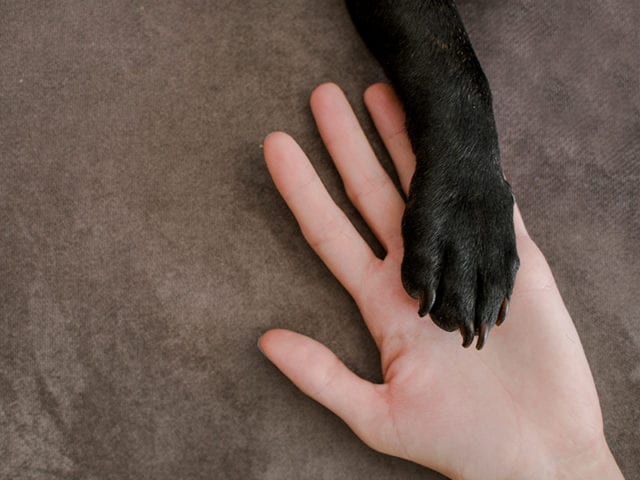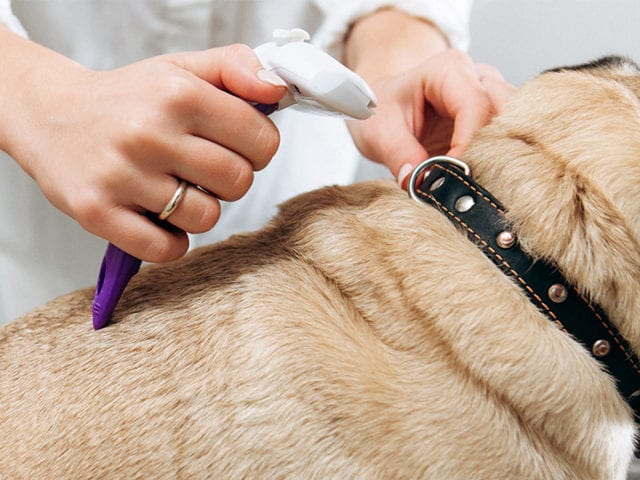Ticks are eight-legged parasites that latch onto your dog to suck their blood. Although extremely tiny, these bloodsuckers can swell to the size of a pea. They use their mouth to dig into the skin of your fur baby and thrive in moist and warm areas; your pet’s hairy coat serves as the perfect feeding ground.
But, the good news is, they are big enough to spot with the naked eye. In fact, much like lice in children, ticks are commonplace in your dogs when they’re at their peak of curiosity and playfulness. Ticks are most common in and around a dog’s ears, or the head region; that said, they can be on other parts of the body and you need to feel out the dog’s skin surface to keep a check. Apart from transmitting diseases, a dog tick usually causes irritation and redness on their skin.
A lot of pet owners often have varied misconceptions like ticks in dogs can get transferred to humans and can cause Lyme Disease or Rocky Mountain Spotted Fever. However, this is far from the truth. Dogs are not considered to be a direct source of infection. Lyme Disease or any other tick-related disease cannot be transmitted from one dog to another, or from your pet to you. Nevertheless, a carrier tick can come to your house via your dog’s fur and attach itself on you. and that’s when you are open to infection.
Before we look at how to prevent ticks on dogs, let’s look into what causes these ticks.
What Causes Ticks In Dogs?

It is not uncommon to find ticks on dogs. These nettlesome parasites attach themselves to your dog’s coat and are quite hard to remove. If left on their own, these nasty-looking bloodsuckers can cause some serious diseases to your dogs. Now, how do ticks get on dogs?
If your dog plays in any woody or bushy area or when you go out to walk your dog, they can pick up one or two ticks through a process called questing, where they usually leave the vegetation and hold on to their host. But the main thing to keep in mind is that the ticks don’t transmit diseases immediately. If you remove these ticks within 24 to 36 hours, then your dog is unlikely to get infected.
The Different Types Of Ticks On Dogs
Ticks are usually classified into various categories. It depends upon the geographic location, the climatic conditions and various other significant factors.
1. Hard Ticks

Hard ticks are the most common type of ticks in American dogs and are usually flat-shaped like a seed. They are chestnut brown in colour with white spots or streaks on their back. They usually live for up to two years without food.
2. Lone Star Ticks

They come in various shades of brown and tan. They live in wooded or bushy areas and the females have a single silvery-white spot on their back, while the males have scattered white spots.
3. Deer Or Black Legged Ticks

They feed on a variety of hosts including dogs and people. Just like lone star ticks, they are also found along woody trails. The females can usually lay up to 2000 eggs during spring.
4. Brown Dog Tick

They are narrow in shape in comparison to the other ticks. Dogs are their primary host and they can spread very easily. You often see them around your dog’s kennel or their beds. They have the capacity to complete their entire life cycle indoors.
5. Soft Ticks

Unlike hard ticks, soft ticks don’t have a hard shell and often look like a raisin. They can cause relapsing fever in your dogs. Their bites are painless and they can go unnoticed. However, these types of ticks on dogs along with the lone star ticks are quite common in Indian dogs.
How To Prevent Ticks On Dogs?

These preventive measures are safe and effective and can be carried out to protect your fur babies.
- If you live in an area where ticks are quite common, ask your veterinarian what is the best option to deal with these pesky creatures.
- Examine your dog every time you return from a walk in the park or a woody area. Ticks on a dog’s ears, between toes, head and neck region are extremely common. Use a tick removal tool to carefully remove them from your dog’s skin once you feel a tiny little lump. Remember to clean the area from where you just dislodged the tick carefully.
- Another natural preventive measure is to add garlic and apple cider vinegar to your dog’s diet. This makes your dog’s blood less appealing to the ticks.
- Always remember to not kill the tick with your fingers. The blood of a tick is dangerous and flushing it down the toilet won’t kill it too. Thereby it is advised to drop them in rubbing alcohol and it should do its job.
- Some ultrasonic pest repellents, apart from repelling mosquitoes also repel ticks and fleas. You can install one of these in your yard and witness its magic.
- The smell of lavender, citrus and cinnamon is usually unappealing to a tick. You can try these out on your dog by spraying a dog perfume which is nowadays readily available in any pet shop, and which has these essential oils or scents in them.
- For a short while, walk your dog indoors or on the terrace. Avoid taking your dog out until the tick infestation has subsided (like during the rainy season).
Tick Treatment For Dogs
There are several treatment options available in case your dog has ticks. Ticks on puppies can lead to severe illnesses, so the sooner you adopt a treatment method the better.
1. Topical Treatments

Topical treatments, like Advantix, are liquids or gels that you traditionally place along your dog’s spine and let it absorb into his/her skin. You will have to make sure your dog can’t reach it once you’ve applied the treatment. You may want to invest in a t-shirt for your doggo to protect him/her or your other pets from bothering or ingesting it.
There are also sprays that you can buy that shall get rid of any ticks that are on your dog and act as a repellent for any ticks heading your dog’s way. Use a cotton ball to apply this to your dog’s ears or head region. The general idea should be to spray it on the affected area and to not soak your pup in the spray. Make sure you’re always spraying these chemicals in a well-ventilated area and away from the dog’s eyes, nose and mouth.
2. Shampoos, Sprays & Dips

Nowadays, tick-repellent shampoos and sprays are quite readily available in the market. Only after consulting your vet, get such a dip or a shampoo which will not only kill the existing ticks but also protect your dog from further infestation. Dips are a leave-in option, so if you are using a dip make sure that your dog is not licking it because that can be dangerous. You may want to get a neck cone to ensure he doesn’t end up ingesting the dip.
3. Oral Medications

Oral medications are usually prescribed by the vet as an alternative tick treatment plan. They might be your most handy and convenient option because you don’t need to apply them on any body part of your pet, thus ensuring that your furry friend is safe from licking away those chemicals.
4. Spot-On Treatments

As the name suggests, spot-on treatments are applied just on the area where the tick has latched on to your pup or dog. They are effective for up to a month or maybe more, depending on the type of spot-on treatment you are using. Make sure to read the instructions and the label carefully before using it on your dog.
5. Treat Your House & Lawn Properly

Ticks usually prefer warm and woody areas. Make sure you mow the grass off your lawn. Believe it or not, short grass can actually prevent ticks. Clean your pet’s bedding properly. It’s advisable to treat your entire house to avoid the possibility of a carrier tick from infecting the family members as well.
Ticks on puppies and dogs are quite common nowadays so there’s nothing to worry about. As a pet owner, it should be your responsibility to practice the preventive measures to avoid future tick infestation and if your fur baby is already suffering from it, please consult your vet to discuss the correct tick treatment for dogs.
The protection of animals is enshrined as a fundamental duty in the Indian Constitution. Watch this video to learn which animal laws help pets and strays in India.

